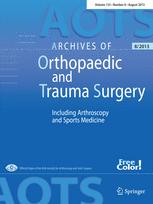
SHOULDER & ELBOW
US guidance is beneficial in arthroscopic debridement for calcific rotator cuff tendinitis
This report has been verified
by one or more authors of the
original publication.
Arch Orthop Trauma Surg. 2014 May;134(5):651-6. doi: 10.1007/s00402-014-1927-6. Epub 2014 Feb 1.
20 patients undergoing arthroscopic debridement for calcific rotator cuff tendinitis were randomized to have the deposit located either with ultrasound guidance or using conventional methods. The purpose of this study was to compare these two techniques with respect to the number of needle punctures and time required to locate the calcific deposit, as well as shoulder pain and function, over a period of 9 months. Results indicated that, although both groups yielded excellent results, the use of US guidance significantly reduced the number of needle punctures and the amount of time required to detect the calcific deposit. Shoulder pain and function were statistically similar between groups at all time points.
Unlock the full ACE Report
You have access to {0} free articles per month.Click below to unlock and view this {1}
Unlock NowCritical appraisals of the latest, high-impact randomized controlled trials and systematic reviews in orthopaedics
Access to OrthoEvidence podcast content, including collaborations with the Journal of Bone and Joint Surgery, interviews with internationally recognized surgeons, and roundtable discussions on orthopaedic news and topics
Subscription to The Pulse, a twice-weekly evidence-based newsletter designed to help you make better clinical decisions
Exclusive access to original content articles, including in-house systematic reviews, and articles on health research methods and hot orthopaedic topics
Or upgrade today and gain access to all OrthoEvidence content for just $1.99 per week.
Already have an account? Log in


Subscribe to "The Pulse"
Evidence-Based Orthopaedics direct to your inbox.
{0} of {1} free articles
Become an OrthoEvidence Premium Member. Expand your perspective with high-quality evidence.
Upgrade Now













































































